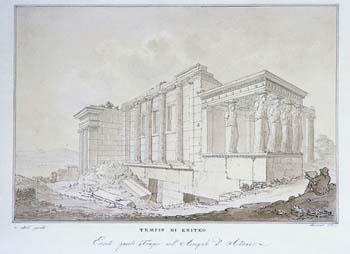Tempio di Eriteo (Erechtheum Temple)
- ca. late 18th century
- Sebastiano
- Pen and ink drawing
15.7 x 23.3 cm., 6-1/4 x 9-1/4" image
- Catherine Carter Goebel, Paul A. Anderson Chair in the Arts Purchase, Paul A. Anderson Art History Collection, Augustana College 2000.36

Essay by Jennifer Windmiller, Class of 2007
Today's culture is accustomed to taking photographs of events that occur throughout our lives that we wish to capture and remember forever. Even more recently, with the advent of the computer age and digital photography, we take for granted the instantaneous record that we might capture and transmit to others. This wish to preserve and share an experience is not a newly developed concept. Sebastiano's Tempio di Eriteo demonstrates similar interests in response to the international Neoclassical movement.
The Tempio di Eriteo is a snapshot, of sorts, of one of the most revered stops along the Grand Tour. This Grand Tour consisted of extensive travel, primarily in Greece and Italy, often culminating with Rome, the Eternal City and a center for classical culture. It drew people from all over the United States and Europe, attracting a variety of devotees seeking intellectual and cultural enrichment. Many young gentlemen who embarked in their early to mid-twenties on the Grand Tour, considered it a final step in their formal education before taking on the responsibilities of manhood. The Neoclassical movement fueled this desire to directly confront the past and to seek inspiration from the classical cultures of ancient Greece and Rome.
The Tempio di Eriteo, one of many temples on the Acropolis in Athens, is distinctive for its caryatids (vertical supports carved into female figures) making up the Porch of the Maidens seen on the right side of the drawing. Sebastiano drew a picturesque atmosphere and applied the same compositional characteristics to paper that tourists today capture in a photograph, and in the same manner, this portable art could be taken anywhere to be admired by anyone. It is quite simple in format, yet very detailed in the ruin itself. The figure sketching in the lower right corner establishes scale and invites the viewer of this drawing to also study the ruins and develop an even deeper appreciation for its grandeur.
The Tempio di Eriteo and other such Grand Tour drawings were not just memories captured for an eighteenth-century audience. They have also become modern culture's snapshots from the past, and even though they do not reflect our own personal memories, we can appreciate and enjoy the drawings since they enable us to experience the ruins within their historic context. This drawing reveals to us in the twenty-first century, just how people over two centuries ago revered great monuments erected some twenty-three centuries before their time. In this manner, such images allow us access both to the ancient as well as the more recent past and seem to invite us to also visit the Erechtheum in order to construct our own context for such ancient wonders.
